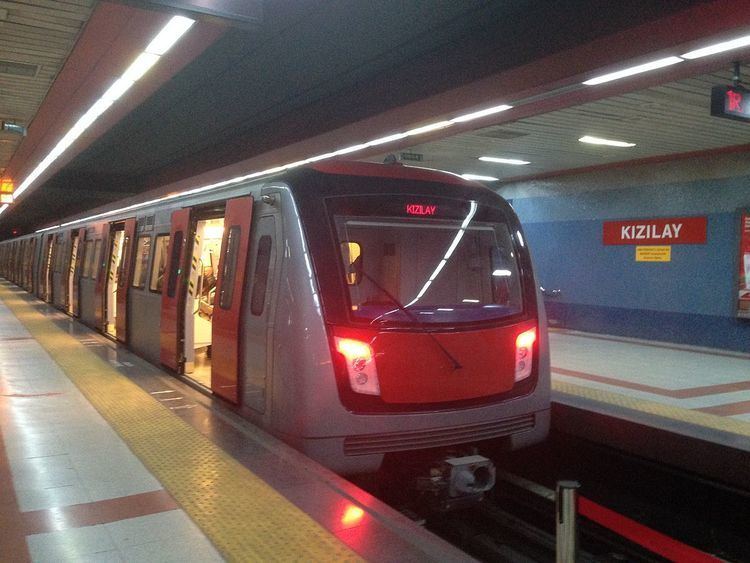Number of stations 54 | ||
 | ||
Number of lines 4(1 more under construction) Daily ridership 289,155 (average, 2014) | ||
The Ankara Metro (Turkish: Ankara Metrosu) is the rapid transit system serving Ankara, the capital of Turkey. At present, Ankara's rapid transit system consists of four metro lines – the light rail Ankaray line, the Batıkent Metrosu (M1), the Koru Metrosu (M2) and Törekent Metrosu (M3) lines and the new Keçiören Metrosu (M4) line opened in 2017. The Ankaray, the M1, M2 and M3 lines, together transported 104.1 million passengers in 2014, which corresponds to a ridership of approximately 289,155 per day.
Contents
- Ankaray
- Ankara Metro
- Future Service
- Lines
- Ankaray A1
- Batkent Metrosu M1
- Koru Metrosu M2
- Trekent Metrosu M3
- Keiren Metrosu M4
- References
The Kızılay to Atatürk Cultural Center link of M4 is not yet opened and remains under construction. Also, an additional line (approx. 30 km long) between Kızılay and Ankara Esenboğa Airport is in the planning stages and would make up the next phase of expansion of the metro.
Ankaray
The Ankaray (from Turkish: Ankara ray, meaning Ankara rail), a light rail system (Turkish: Hafif Raylı, which literally translates as "Light Rail", though the line does operate as more of a "light metro" line) was the first phase of the modern rapid transit network of the city. The Ankaray was constructed by a consortium headed by Siemens over a period of four years (1992–96). It opened on 20 August 1996. The line runs between AŞTİ (Turkish: Ankara Şehirlerarası Terminal İşletmesi – Ankara Intercity Bus Terminal) and Dikimevi, covering a distance of 8.53 kilometres (5.30 mi), of which 6.68 kilometres (4.15 mi) is through underground tunnels. The line has 11 stations.
Ankara Metro
The Ankara Metro has been operating since 29 December 1997, with the opening of its first full metro line, M1, traveling between Kızılay, the city center, and Batıkent.
The M2 line, operating from Kızılay, the city center, to Koru, opened 12 February 2014. The M3 line, which serves almost as an extension of the M1 line, operating from Batıkent to Törekent, opened a month later on 13 March 2014.
Future Service
Construction of the following metro line is currently underway:
The prime minister announced the opening of the Kızılay-Keçiören (M4) line in 2015.
Another extension of the network to the south is being considered. The TBMM–Dikmen line would run for 4.8 km and have five new stations.
The expanded Ankara Metro is expected to reach a carrying capacity of 58,000 passengers per hour per direction in the near future.
Lines
The following table lists the four metro lines (including the Ankaray line) currently in service on the Ankara Metro:
Ankaray (A1)
Batıkent Metrosu (M1)
Koru Metrosu (M2)
Törekent Metrosu (M3)
Keçiören Metrosu (M4)
Ankaray
Ankaray vehicles on the Ankaray line are Siemens-Adtranz-Ansaldobreda, S.P.A. (AnsaldoBreda) M1, M2, and M3 trains, which have a top speed of 80 km/h (50 mph) (operational speed: 38 km/h (24 mph)), and are equipped with regenerative braking.
The system is served by 11 three-car trainsets. Each traincar is 29-metre (95 ft) long, with 60 seats, and can transport a maximum of 308 passengers; thus each three-car trainset is approximately 90-metre (300 ft) long and can transport 925 passengers per train. The current passenger volume capacity on the Ankaray line is 27,000 passengers per hour per direction (PPHPD).
Ankara Metro
The vehicles used on the M1 line of the Ankara Metro are Bombardier Transportation-built modified versions of the sixth-generation H-series trains (previously used on the Toronto subway), which were originally built by the Urban Transportation Development Corporation (UTDC), a company later purchased by Bombardier. The system has a total of 108 vehicles, which are usually configured as 18 six-car trainsets. The cars have no forward- or rear-facing seats, and no seats at the front or rear. The car's seats are made of rigid plastic.
